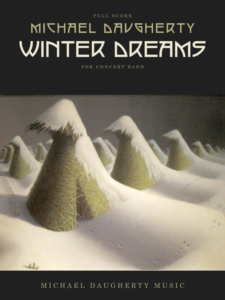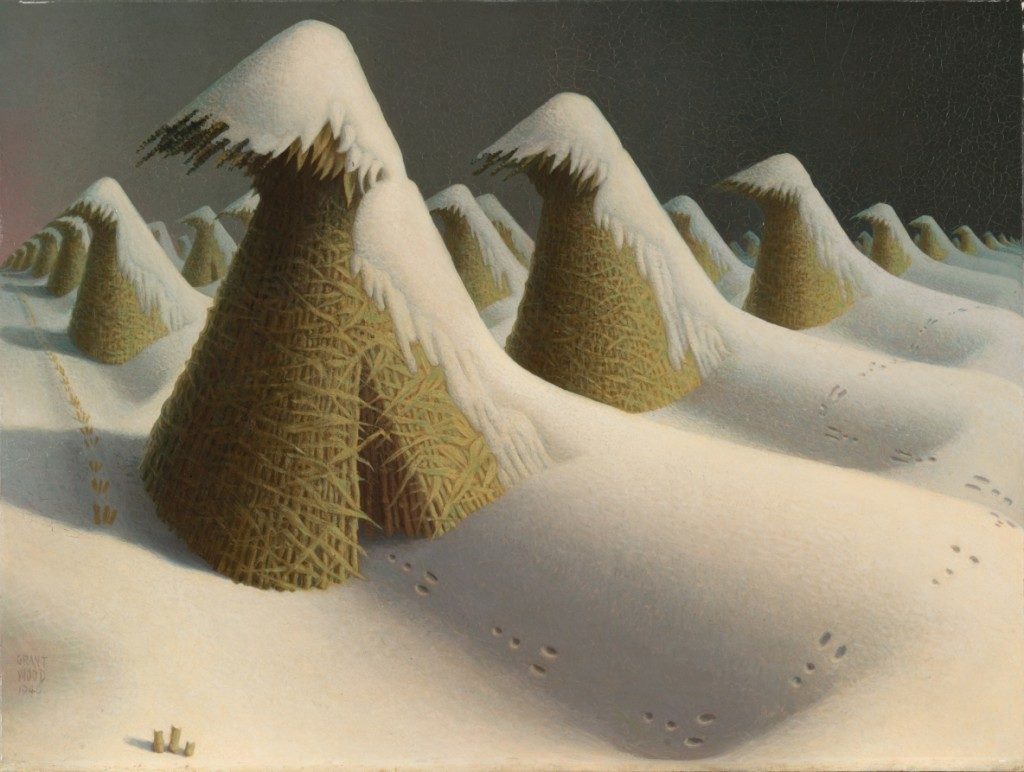Winter Dreams
for concert band (2015)
Instrumentation: Piccolo/Flute,2 Flutes, Alto Flute (optional but preferred), 2 Oboes, English Horn, 4 Bb Clarinets, Bass Clarinet, Bb Contrabass Clarinet, 2 Bassoons, Contra Bassoon, Soprano Saxophone, Alto Saxophone, Tenor Saxophone, Baritone Saxophone, 4 Horns, 3 Bb or C Trumpets (straight metal mute, harmon mute), 3 Trombones (3. Bass) (straight metal mute), 2 Euphoniums (T.C. and B.C.), Tuba, Timpani (Four drums; 32” 29” 26” 23″), Percussion: 5 Players; instruments are not shared 1. Glockenspiel, Crotales, 2. Vibraphone (yarn mallets), 3. Marimba, 4. Chimes, 5. Finger Cymbals, Mark Tree, Sleigh Bells, Bell Tree, Harp (or Piano, if no Harp available), Celesta (or electronic keyboard with “celesta” patch, if no Celesta available), Double Bass (optional but preferred)
Publisher: Michael Daugherty Music
Duration: 8 minutes
World Premiere: Commissioned and premiered by the North Hills High School Wind Ensemble, Leonard Lavelle, Director in recognition of the 50th anniversary of the North Hills High School Commission Series

Program Note:
Winter Dreams for concert band is a contemporary musical reflection on the creative world of Iowa artist, Grant Wood (1891-1942). Composed in memory of my father, Willis Daugherty (1929-2011), the music also reflects on the years when I grew up in Cedar Rapids, Iowa as the oldest of five sons in the Daugherty family.
I first became aware of Grant Wood when I was a ten-year-old boy enrolled in art classes at the old Cedar Rapids Public Library (now the Cedar Rapids Museum of Art). Prominently displayed in the room where we learned to draw and paint was Grant Wood’s original painting of his mother, entitled Woman with Plant (1928). I realized that Grant Wood was everywhere in Cedar Rapids: his paintings and lithographs at the Museum of Art; his farm mural at the old Montrose Hotel; his carved wooden Mourner’s Bench in the principal’s office at McKinley Junior High School; his stained glass Memorial Window at the Veteran’s Memorial Building. I often rode my bicycle past the artist’s studio at 5 Turner Alley, where Grant Wood created his most famous painting, American Gothic (1930).
My father was a fan of Grant Wood’s regionalist art. He was a tour guide at the Grant Wood Studio, and he displayed reproductions of American Gothic along with Stone City (1930) at his home. Much like a character in the background of Grant Wood’s paintings from the 1930’s, my father milked the cows and fed the horses every morning on the farm before walking several miles down a desolate gravel road to a one-room country grade school located in Walker, Iowa.
In 2012, I returned to Cedar Rapids to revisit the small towns of Eastern Iowa. I drove along the back roads and farms where my father grew up, and where Grant Wood found inspiration for the people and places captured in his art. All the while, I was collecting musical ideas and mental images to create an emotional framework for my composition.
Winter Dreams is inspired by the bleak winter scenes of rural Iowa depicted in Grant Wood’s black and white lithographs of the 1930’s, such as January and February. A haunting melody evokes a cold winter wind whistling “down in the valley.” The title of this movement hearkens back to Jay Sigmund (1885-1937). As an Iowa poet and close friend of Grant Wood, Sigmund was instrumental in persuading Wood to turn his attention from France back to Iowa for artistic inspiration. In a poem entitled “Grant Wood,” Sigmund describes how “time found a new son / Dreaming on the plain.”
–Michael Daugherty

